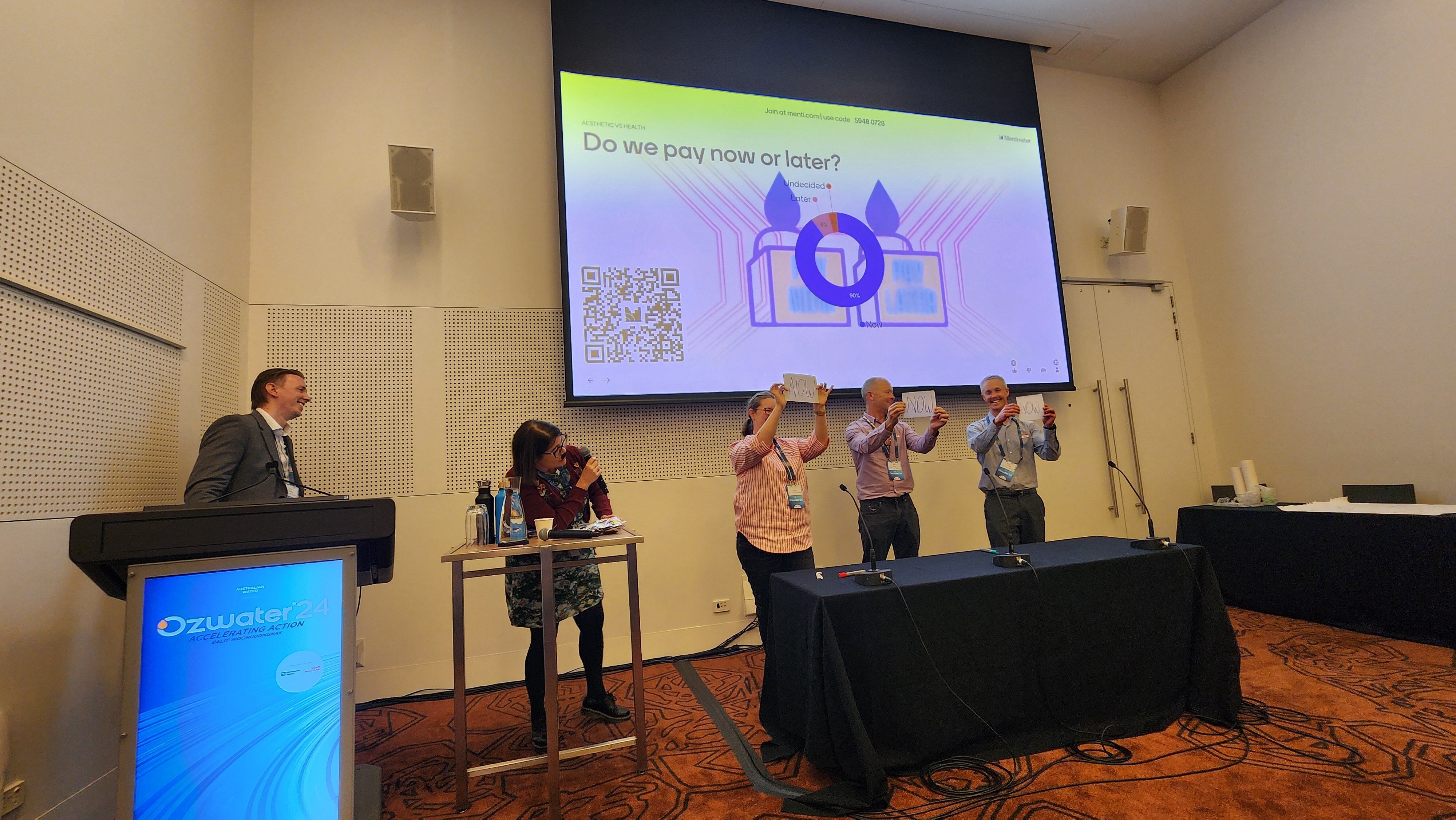Ozwater’24 – Pay now or Pay later

Pay now or pay later: water quality investment strategy considerations
When it comes to protecting waterway health, is it better to pay now or pay later?
What are the benefits of paying now by investing in a more holistic catchment management strategy including improvements such as bank stabilisation, stormwater management or nutrient offsets, or to pay later by investing in engineered treatment solutions to mitigate nutrient levels?
At Ozwater’24 in Melbourne earlier this year, the AWA Water Quality Specialist Network hosted a session that took a slightly unorthodox approach to the typical panel discussion format.
With a dizzying array of faux moustaches on display, the Specialist Network took a spin through the realm of classic 1970s game show formats to explore the question of whether it’s best to pay now or pay later.
Across three rounds, the audience was invited to consider this question through a series of case studies relating to investment in water quality and balancing competing drivers, with the opportunity to win a rainbow mustache.
Engineered treatment solutions, such as reverse osmosis, offer immediate and controlled mitigation of nutrients from a point source without regard for any other nutrient sources from the waterway’s catchment, and often at a high capital and carbon cost.
Conversely, managing nutrient sources more widely involves lower capital costs and negligible carbon emissions, but entails higher operational costs and uncertainty around long-term ownership and maintenance and, consequently, uncertainty around long-term efficacy.
Aesthetic qualities and community health
Audience participation stepped up a notch in this round with game show contestants trying their hand at assessing the quality of two different water samples against the Australian Drinking Water Guidelines (ADWG) for total dissolved solids (TDS).
While both samples were of course safe to drink, the ease with which the contestants correctly identified the sample that did not meet the aesthetic guidelines was used to highlight the investment dilemma.
In the fictional town of "Saltyville", the water is above the ADWG guidelines for TDS, which consumers can detect and therefore are adverse to drinking.
Should the water utility pay now to improve treatment capability, or will the community pay later through poorer health outcomes as consumers divert to bottled water (leading to potential dental health issues) or soft drinks (leading to possible obesity issues)?
In the last round, contestants were asked to consider a challenge that seemed all too familiar for some: the public and sometimes political demand for recreational access into drinking water catchments.
For those in the audience charged with the responsibility of ensuring the quality of water produced by treatment facilities, allowing recreational use within catchment areas would typically lead to a reassessment of the upstream risks to the facility and a requirement for additional investment in treatment capability. This is balanced against the community benefit of having access to these areas.
The question posed to contestants was: would you pay now and plan in advance for recreational access to drinking water catchments, effectively investing to overtreatment until recreational access is granted, or pay later and potentially have to either fight against access or accelerate treatment plant upgrades in the future to mitigate the risk to public health.
Pay now pays off
Across all three rounds, there was a clear preference to pay now, typically in the form of favoring investment in treatment capabilities.
This preference was a sign of a highly risk adverse audience, and obviously not those signing off on budget requests. The engaging discussion among the audience and panel highlighted that these results are somewhat biased by the composition of the audience, and that there are usually a range of other considerations for key decision makers.
Overall, the panel did an excellent job of discussing obstacles faced by communities and water utilities when confronted with water quality challenges. The scenarios presented and following discussion highlighted the complexity of these issues.
Interested in contributing to Ozwater’25? The Ozwater’25 presentation pitches are now open across 13 categories.
